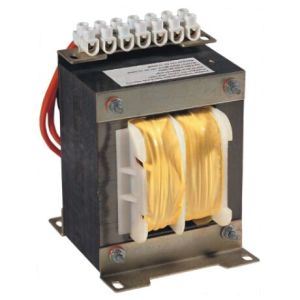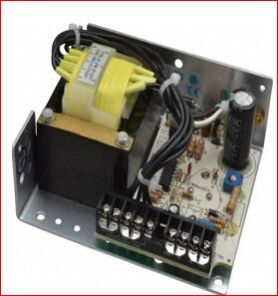
Laminated Transformer
prayog systems offer a range of laminated transformers designed to your specification using the most up-to-date designs, materials, and manufacturing techniques. basic design requirements input voltages and frequency output voltages and currents size requirements termination - eg tags/ pins/ terminal blocks/ flying heads fixing - pcb, frame or clamp finish - air drying varnish or vacuum pressure impregnation varnish plus tropicalisation (enveloped) safety requirements - overload protection using thermal cutouts product details : metric or imperial laminations split bobbin construction insulation class "b" 130° c or higher .
Cooling Type : Dry Type/Air Cooled
Phase : Single Phase & Three phase
Power : Up to 100 MVA
...more
SMPS
In a PC, the computer power supply is the metal box usually located in the corner of the computer case. In many systems the power supply is visible from the back of the case because it contains the power-cord receptacle and the cooling fan. The main purpose of the power supply is to convert AC power from the mains to usable low-voltage DC power for the internal components of the computer. The power supply gives out three different DC voltages to your computer, 12VDC, 5VCD, and 3VDC. These three voltages are used for different components in your system. For example, the 5VDC voltage powers the motherboard, voltage regulators, serial and parallel ports, and PCI and AGP ports. How Much Power Do You Need? Each power supply has a certain wattage based on their maximum output power. Common wattages range from 300W to 500W, although for a high-end gaming power supply wattages of 500W to 800W are common. Some units even go up to 1 kW of wattage, but this amount of power isn't necessary for normal users.
...more
Linear Power Supply
A simple AC powered linear power supply usually uses a transformer to convert the voltage from the wall outlet (mains) to a different, usually a lower voltage. If it is used to produce DC a rectifier circuit is employed either as a single chip, an array of diodes sometimes called a diode bridge or Bridge Rectifier, both for fullwave rectification or a single diode yielding a half wave (pulsating) output. More elaborate configurations rectify the AC voltage at first to pulsating DC. Then a capacitor smooths out part of the pulses giving a type of DC voltage. The smaller pulses remaining are known as ripple. Because of a fullwave rectification they occur at twice the mains frequency (in USA it's 60 Hz doubled to 120 Hz). Finally, depending on the requirements of the load, a linear regulator may be used to reduce the ripple sometimes also allowing for adjustment of the output to the desired but a lower voltage. More elaborate versions used by circuit designers are adjustable up to 30 volts and up to 5 amperes output. These often employ current limiting. Some can be driven by an external signal, for example, for applications requiring a pulsed output. In the simplest case a single diode is connected directly to the mains and uses a resistor in series with a more or less fixed load to recharge a battery. This circuit is common in rechargeable flashlights. Selectable 110/240VAC Linear regulated Clean output with less than 2mV ripple Output adjustable from 5 to 25V Two chassis formats available
Frequency : 60 Hz doubled to 120 Hz
...more
convertors
Type Of Convertors AC/DC (rectifier, 230Vac to dc voltage) DC/DC (converter, dc voltage of one value to dc voltage of another value) DC/AC (inverters, shape of output voltage sinus and quazi sinus) Features Standard topologies: Flyback, Forward, Push-Pull; developing of converters with soft switching configurations available on user demand Efficiency more than 95% Wide range of ac/dc converter input ac voltage According to user requirements, PFC at input Different input voltages of dcdc converters: 300V, 110V, 48V, 24V, 12V Different output voltages: 3.3V, 5V, 12V, 24V, 48V, 110V, 220V, 310V or -3.3V, -5V, -12V, -24V, -48V, -110V, -220V, -310V, according to user requirements, multiple outputs voltages available Quality of converters output voltages according to standards for telecommunication equipment and user demands Production technology: hybrid, semi hybrid and discrete; smd widely used; possibility of adjustment and modifications of geometry, device dimensions and input-output details, in accordance with user requirements Safety standards are satisfied Passive or active (forced) cooling Active and passive input-output protections of various types: over voltage, under voltage, overcharged, short connections protection, thermal protection Many types of signalization and communications in accordance with user demands
...more
Bare Board
Wide range input 110/240VAC Short circuit, overload, over voltage and temperature protected Fixed 100kHz switching frequency Free air convection cooling 100% full load burn in testing
...more
Atx Power Supply
A simple AC powered linear power supply usually uses a transformer to convert the voltage from the wall outlet (mains) to a different, usually a lower voltage. If it is used to produce DC a rectifier circuit is employed either as a single chip, an array of diodes sometimes called a diode bridge or Bridge Rectifier, both for fullwave rectification or a single diode yielding a half wave (pulsating) output. More elaborate configurations rectify the AC voltage at first to pulsating DC. Then a capacitor smooths out part of the pulses giving a type of DC voltage. The smaller pulses remaining are known as ripple. Because of a fullwave rectification they occur at twice the mains frequency (in USA it's 60 Hz doubled to 120 Hz). Finally, depending on the requirements of the load, a linear regulator may be used to reduce the ripple sometimes also allowing for adjustment of the output to the desired but a lower voltage.
...more
Adaptors
An adaptor is a device used to match the physical or electrical characteristics of two different things so that a connection may be made between them. Adapter are device that changes what is passing through, such as a transformer that adapts household electrical current from high voltage (100 to 240 volts AC) to low voltage (3 to 24 volts DC) suitable for consumer electronics Prayog Systems Manufactures custom AC-DC adapters to match your specifications.
...moreBe first to Rate
Rate ThisOpening Hours